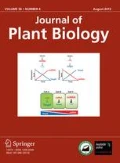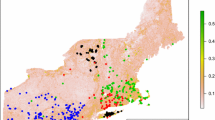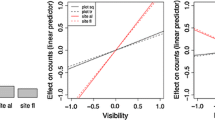Abstract
As part of an on-going effort to conserve endangered and endemicScrophularia takesimensis (Scrophulariaceae), we analyzed its spatial distribution patterns by applying an index of dispersion, plant-to-all-plant distances, and the varying quadrat size method. Three indices — Dispersion, Morisita, and Standardized Morisita — all revealed clumping with small aggregates, and distances between aggregates were more or less regular. The asymptote level occurred at a distance of 20 to 30 m; the distance showing 90% of cumulative frequency coincided with 20 to 21 m; 95%, 24 to 25 m; and 99%, 31 to 32 m. The 20 m× 20 m and 40 m×40 m quadrats contained 25 and 40 plants, respectively. We conclude that this number of individuals and size of area are the minimum required for the conservation of this species.
Similar content being viewed by others
Literature cited
Alados CL, Pueyo Y, Giner ML, Navarro T, Escos J, Barroso F, Cabezudo B, Emlen JM (2003) Quantitative characterization of the regressive ecological succession by fractal analysis of plant spatial patterns. Ecol Model163: 1–17
Aldrich PR, Parker GR, Ward JS, Michler CH (2003) Spatial dispersion of trees in an old-growth temperate hardwood forest over 60 years of succession. For Ecol Manage180: 475–491
Arevalo JR, Fernandez-Palacios JM (2003) Spatial patterns in trees and juveniles in a laurel forest of Tenerife, Canary Islands. Plant Ecol165: 1–10
Austin MP (2002) Spatial prediction of species distribution: An interface between ecological theory and statistical modeling. Ecol Model157: 101–118
Barbour MC, Burk JH, Pitts WD (1980) Terrestrial Plant Ecology. The Benjamin/Cummings Publishing Company, Inc., Menlo Park, CA, USA.
Bond WJ, Midgley JJ (2001) Ecology of sprouting in woody plants: The persistence niche. Trend Ecol Evol16: 45–51
Bunyavejchewin S, LaFrankie JV, Baker PJ, Kanzaki M, Ashton PS, Yamakura T (2003) Spatial distribution patterns of the dominant canopy dipterocarp species in a seasonal dry evergreen forest in western Thailand. For Ecol Manage175: 87–101
Chang CS, Jeon JI (2003) Leaf flavonoids inCotoneaster wilsonii (Rosaceae) from the island Ulleung-do, Korea. Biochem Syst Ecol31: 171–179
Chen J, Bradshaw CA (1999) Forest structure in space: A case study of an old growth spruce-fir forest in Changbaishan Natural Reserve, PR China. For Ecol Manage120: 219–233
Chokkalingam U, White A (2001) Structure and spatial patterns of trees in old-growth northern hardwood and mixed forests of northern Maine. Plant Ecol156: 139–160
Dale MR (1999) Spatial Pattern Analysis in Plant Ecology. Cambridge University Press, Cambridge.
Endels P, Jacquemyn H, Brys R, Hermy M, Blust GD (2002) Temporal changes (1986–1999) in populations of primrose (Primula vulgaris Huds.) in an agricultural landscape and implications for conservation. Biol Conserv105: 11–25
Ennos AR (1997) Wind as an ecological factor. Trend Ecol Evol12: 108–111
Forbes DL, Parkes CS, Manson GK, Ketch LA (2004) Storms and shoreline retreat in the southern Gulf of St. Lawrence. Mar Geol210: 169–204
Galiano EF (1982) Pattern detection in plant populations through the analysis of plant-to-all-plant distances. Vegetatio49: 39–43
Getis A (1984) Interaction modeling using second-order analysis. Environ Plan A16: 173–183
Getis A, Franklin J (1987) Second-order neighborhood analysis of mapped point patterns. Ecology68: 473–477
Hoshino D, Nishimura N, Yamamoto S (2001) Age, size structure and spatial pattern of major tree species in an old-growthChamaecyparis obtusa forest, Central Japan. For Ecol Manage152: 31–43
Hyun JO (2001) Categorization of the Threatened Plant Species in Korea. Ph.D. Thesis, Soonchunhyang University, Asan, Korea
Jordan MJ, Patterson III WA, Windisch AG (2003) Conceptual ecological models for the Long Island pitch pine barrens: Implications for managing rare plant communities. For Ecol Manage185: 151–168
Kingston N, Waldren S, Smyth N (2004) Conservation genetics and ecology ofAngiopteris chauliodonta Copel. (Marattiaceae), a critically endangered fern from Pitcairn Island, South Central Pacific Ocean. Biol Conserv117: 309–319
Krebs CJ (1999) Ecological Methodology, Ed 2. The Benjamin/Cummings Publishing Company, Inc., Menlo Park, CA, USA
Lee S, Ma S, Lim Y, Choi H-K, Shin H (2004) Genetic diversity and its implications in the conservation of endangeredZostera japonica in Korea. J Plant Biol47: 275–281
Lee T, Yamazaki T (1983) A revision of the Scrophulariaceae in Korea. Bull Kwanak Arb 8, Suppl 34—70
Lim YS, Shin H, Hyun JO, Cho KH (2000) Ecological characteristics of remnant populations in the rare plantScrophularia takesimensis Nakai. Kor J Biol Sci4 (Suppl), 126 (Abstract)
Marrs RH, Frost AJ, Plant RA, Lunnis P (1993) Determination of buffer zones to protect seedlings of nontarget plants from the effects of glyphosate spray drift. Agric Ecosys Environ45: 283–293
Menges ES (2000) Population viability analyses in plants: Challenges and opportunities. Trend Ecol Evol15: 51–56
Min BM (2007) Population ecology in a naturalSyneilsis palmate stand: II. Vegetative growth and population structure. J Plant Biol50: 423–429
Miyadokoro T, Nishimura N, Yamamoto S (2003) Population structure and spatial patterns of major trees in a subalpine oldgrowth coniferous forest, central Japan. For Ecol Manage182: 259–272
Morisita M (1959) Measuring of the dispersion of individuals and analysis of the distributional patterns. Mem Fac Sci Kyushu Univ Ser E (Biology)2: 215–235
North M, Greenberg J (1998) Stand conditions associated with truffle abundance in western hemlock/Douglas-fir forests. For Ecol Manage112: 55–66
Olive H, Lee K, Williams GA (2002) Spatial distribution patterns ofLittoria species in Hong Kong mangroves. Hydrobiologia481: 137–145
Osunkoya OO (1999) Population structure and breeding biology in relation to conservation in the dioeciousGardenia actinocarpa (Rubiaceae) — a rare shrub of North Queensland rainforest. Biol Conserv88: 347–359
Peterson CJ (2000) Catastrophic wind damage to North American forests and the potential impact of climate change. Sci Tot Environ262: 287–311
Ripley HD (1976) The second-order analysis of stationary point processes. J Appl Prob13: 255–266
Ripley HD (1978) Spectral analysis and the analysis of pattern in plant communities. J Ecol66: 965–981
Quilichini A, Debussche M (2000) Seed dispersal and germination patterns in a rare Mediterranean island endemic (Auchusa crispa Viv., Boraginaceae). Acta Oecol21: 303–313
Schemske DW, Husband BC, Ruckelshaus MH, Goodwillie C, Parker IM, Biship JG (1994) Evaluating approaches to the conservation of rare and endangered plants. Ecology75: 584–606
Shaukat SS, Siddiqui IA (2004) Spatial pattern analysis of seeds of an Arabic soil seed bank and its relationship with aboveground vegetation in an arid region. J Arid Environ57: 311–327
Soehartono T, Newton AC (2000) Conservation and sustainable use of tropical trees in the genusAquilaria I. Status and distribution in Indonesia. Biol Conserv96: 83–94
Sun BY, Stuessy TF (1998) Preliminary observations on the evolution of endemic angiosperms of Ulleung Island, Korea,In TF Stuessy, M Ono, eds, Evolution and Speciation of Island Plants. Cambridge University Press, Cambridge, pp 181–202
Ueno S, Tomaru N, Yoshimaru H, Manabe T, Yamamoto S (2000) Genetic structure ofCamellia japonica L. in an old-growth evergreen forest, Tsushima, Japan. Mol Ecol9: 647–656
Wiles GJ, Schreiner IH, Nafus D, Jurgensen LK, Manglona JC (1996) The status, biology, and conservation ofSerianthes nelsonii (Fabaceeae), an endangered Micronesian tree. Biol Conserv76: 229–239
Zahreddine H, Clubbe C, Baalbaki R, Ghalayini A, Talhouk SN (2004) Status of native species in threatened Mediterranean habitats: The case ofPancratium maritimum L. (sea daffodil) in Lebanon. Biol Conserv120: 11–18
Author information
Authors and Affiliations
Corresponding author
Rights and permissions
About this article
Cite this article
Lim, Y., Na, ST., Lee, SJ. et al. Spatial distribution patterns and implications for conservation ofScrophularia takesimensis (Scrophulariaceae), an endangered endemic species on Ulleung Island, Korea. J. Plant Biol. 51, 213–220 (2008). https://doi.org/10.1007/BF03030701
Received:
Accepted:
Issue Date:
DOI: https://doi.org/10.1007/BF03030701




